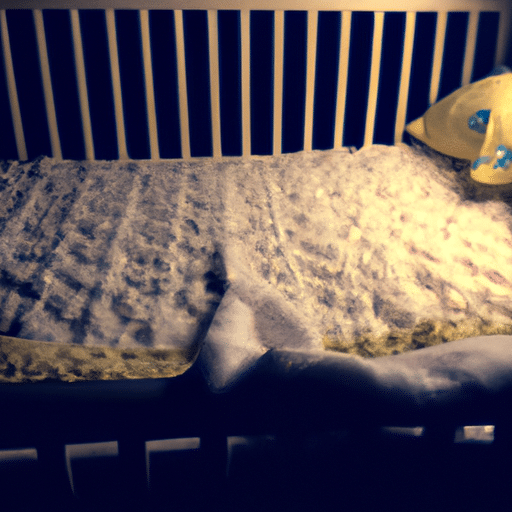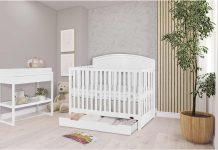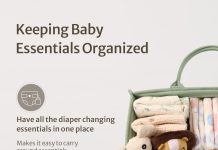Covering a newborn at night can be a perplexing task for new parents, one that demands careful consideration and attention to ensure the baby’s safety and comfort. As the glowing moon casts its soothing light upon their little crib, providing a sense of tranquility, parents often find themselves wondering about the most effective and secure way to keep their precious bundle of joy warm during those tender slumbering nights. With a plethora of options available, finding the ideal approach can be overwhelming. In this article, we will explore various techniques and considerations that can guide parents in choosing the right method to cover their newborn at night, creating a cozy haven for peace and restful sleep.
Review contents
Choosing the Right Bedding
Choosing the right bedding is crucial for providing a comfortable and safe sleep environment for your newborn. There are several factors to consider when selecting bedding for your little one.
Consider the Temperature
One of the most important considerations when choosing bedding for a newborn is the temperature of the room. Newborns are not able to regulate their body temperature as effectively as adults, so it’s essential to ensure they are neither too hot nor too cold during sleep.
In warmer months, opt for lightweight and breathable fabrics that allow for proper air circulation. These fabrics, such as cotton or bamboo, help wick away moisture and prevent overheating. On the other hand, during colder months, consider using thicker materials like flannel or fleece to provide additional warmth.
Opt for Breathable Fabrics
Breathability is another crucial factor to consider when choosing bedding for your newborn. Fabrics that are breathable allow for proper ventilation and reduce the risk of suffocation. Look for bedding made from natural fibers, such as cotton or bamboo, as they tend to be more breathable.
Avoid bedding made from synthetic materials, as they can trap heat and moisture, leading to discomfort and increased risk of overheating. Additionally, make sure the bedding fits snugly on the mattress, without any loose parts that could cover your baby’s face.
Choose the Right Size
Selecting the right size bedding is also important to ensure a safe sleep environment for your newborn. When it comes to crib sheets, choose ones that are specifically designed to fit snugly on a standard crib mattress. A loose-fitting sheet can pose a suffocation hazard, as it may come undone and cover your baby’s face.
Avoid using blankets in the crib during the first year of your baby’s life, as they can increase the risk of Sudden Infant Death Syndrome (SIDS). Instead, opt for a sleep sack or swaddle blanket that provides warmth without the risk of suffocation.
Swaddling Techniques
Swaddling can be a beneficial technique to soothe and comfort your newborn during sleep. However, it’s essential to learn the proper techniques and follow safe practices to ensure your baby’s safety.
Benefits of Swaddling
Swaddling can mimic the feeling of being in the womb and provide a sense of security for your newborn. It can also help prevent your baby’s startle reflex, which can often wake them up during sleep. Swaddling can promote a more restful and longer sleep for your little one.
Safe Swaddling Practices
When swaddling your baby, it’s important to follow safe practices to reduce the risk of suffocation or injury. First, make sure the swaddle is snug but not too tight, allowing room for your baby to move their hips and legs freely.
Always place your swaddled baby on their back for sleep, as placing them on their side or stomach increases the risk of SIDS. Additionally, avoid covering your baby’s head with the swaddle and ensure their face is always uncovered.
Choosing the Right Swaddle Blanket
Selecting the right swaddle blanket is crucial to ensure your baby’s comfort and safety. Look for blankets specifically designed for swaddling, as they often come with features like Velcro or snaps that make it easier to secure the swaddle.
Opt for blankets made from breathable materials like cotton or muslin, as they allow for proper air circulation and reduce the risk of overheating. Also, make sure the blanket is large enough to wrap your baby snugly but not too tight.
Using Sleep Sacks
Sleep sacks, also known as wearable blankets, are a convenient and safe alternative to traditional blankets. They can provide warmth and comfort for your newborn while eliminating the risks associated with loose bedding.
Understanding Sleep Sacks
Sleep sacks are designed to be worn over your baby’s sleepwear, providing an extra layer of warmth without the need for loose blankets. They come in various sizes, styles, and materials, allowing you to choose the one that suits your baby’s needs.
Sleep sacks typically have a zipper or snap closure, making it easy to put on and take off. Some sleep sacks also have a swaddle feature, allowing you to transition from swaddling to a sleep sack as your baby grows.
Choosing the Right Sleep Sack
When choosing a sleep sack, consider the temperature of your baby’s sleep environment and select an appropriate tog rating. Tog rating is a measure of a fabric’s thermal resistance, indicating how well it insulates heat. A lower tog rating is suitable for warmer environments, while a higher tog rating provides more warmth for colder temperatures.
Additionally, choose a sleep sack that fits your baby’s current size and weight. It’s important to ensure a snug fit without any excess fabric that could cover your baby’s face. Always follow the manufacturer’s guidelines for age, weight, and size recommendations.
Tips for Using Sleep Sacks
To ensure safe and proper use of sleep sacks, follow these tips:
- Dress your baby in appropriate clothing underneath the sleep sack. Use layers, depending on the room temperature, to accommodate changes in warmth.
- Regularly check your baby’s body temperature by feeling the back of their neck – it should feel comfortably warm, not sweaty or cold.
- Choose sleep sacks with a fitted neck and armholes to reduce the risk of slipping down over your baby’s face.
- Avoid using blankets or additional bedding inside the sleep sack, as this can increase the risk of overheating or suffocation.
By following these tips, you can create a safe and comfortable sleep environment for your little one while using sleep sacks.
Layering Clothing
Layering clothing is an effective way to regulate your baby’s body temperature during sleep and keep them comfortable throughout the night. It allows you to easily add or remove layers depending on the room temperature and your baby’s individual needs.
Importance of Layering
Layering clothing provides flexibility in managing your baby’s comfort level during sleep. By adding or removing layers, you can ensure they stay warm enough without overheating.
Newborns have a limited ability to regulate their body temperature, making them more susceptible to changes in the environment. Layering clothing allows you to respond to these changes and maintain a cozy sleep environment for your little one.
Choosing Appropriate Clothing
When layering clothing for your newborn, it’s important to choose appropriate fabrics and sizes. Opt for breathable materials like cotton or bamboo, as they allow for proper air circulation and help prevent overheating.
Begin with a onesie or a lightweight bodysuit as a base layer, depending on the room temperature. You can then add additional layers such as footed pajamas, sleep gowns, or sleep sacks, depending on the desired level of warmth.
Avoid dressing your baby in layers that are too tight, as they can restrict movement and cause discomfort. Additionally, make sure the clothing is the right size, with enough room for your baby to move their arms and legs comfortably.
Avoid Overheating
Overheating can pose risks to your newborn’s health, so it’s important to prevent excessive warmth during sleep. Signs of overheating include sweating, flushed skin, rapid breathing, and restlessness.
To avoid overheating, monitor the room temperature and dress your baby accordingly. Keep the room temperature between 68-72°F (20-22.2°C) for a comfortable sleep environment. Ensure that the clothing layers are not too thick and heavy, and regularly check your baby’s body temperature to ensure they are not too warm.
By following these guidelines, you can ensure your baby stays comfortable and safe while layering clothing during sleep.
Placing the Baby in the Crib
The way you position your baby in the crib and the type of mattress you use play crucial roles in creating a safe sleep environment. By following the recommended practices, you can reduce the risk of Sudden Infant Death Syndrome (SIDS) and provide a comfortable sleeping space for your little one.
Positioning the Baby
Always place your baby on their back for sleep to minimize the risk of SIDS. This position allows for optimal airflow and reduces the likelihood of your baby rebreathing their own exhaled carbon dioxide.
Avoid placing your baby on their stomach or side, as it increases the risk of suffocation. While some parents may worry about their baby spitting up during sleep, research shows that the risk of choking is actually higher when babies sleep on their stomachs.
Using a Firm Mattress
Ensure that your baby’s crib mattress is firm and fits snugly in the crib. A firm mattress helps reduce the risk of suffocation and ensures that your baby’s airway remains open.
Avoid using soft mattresses, pillow-tops, or memory foam mattresses, as they can contour to your baby’s face and increase the risk of suffocation. Additionally, keep the crib free from pillows, blankets, stuffed animals, and other soft objects that could pose suffocation hazards.
Creating a Safe Sleep Environment
Apart from the positioning and mattress, there are additional measures you can take to create a safe sleep environment for your baby:
- Use a crib that meets current safety standards and has slats that are no further than 2-3/8 inches (6 cm) apart. This prevents your baby from getting trapped between the crib bars.
- Remove any cords, strings, or ribbons that could present a strangulation hazard.
- Keep the crib away from windows, curtains, blinds, and other potential hazards that your baby could reach or get entangled in.
- Ensure that the room temperature is comfortable and within the recommended range (68-72°F or 20-22.2°C).
- Regularly check the crib for any loose parts or damage that could pose a safety risk.
By following these guidelines and creating a safe sleep environment, you can promote your baby’s health and reduce the risk of sleep-related accidents.
Considering Additional Safety Measures
In addition to the fundamental practices of bedding, swaddling, and positioning, there are additional safety measures you can take to provide a secure sleep environment for your newborn.
Monitoring the Room Temperature
Keeping an eye on the room temperature is crucial for ensuring your baby’s comfort and safety during sleep. Invest in a reliable room thermometer to help you monitor the temperature accurately.
Maintain a room temperature between 68-72°F (20-22.2°C) to create a sleep-friendly environment. It’s ideal to dress your baby in breathable clothing and adjust the layers accordingly to prevent overheating or chilling.
Avoiding Pillows and Bumper Pads
Pillows and bumper pads may seem cozy, but they pose significant safety risks for newborns. Avoid using pillows, cushions, or stuffed animals in the crib, as they can increase the risk of suffocation or suffocation accidents.
Bumper pads, which are designed to line the inside of the crib, can also pose hazards. They may entrap your baby’s head, face, or limbs, leading to injury or suffocation. Instead of using bumper pads, keep the crib free of any unnecessary objects and ensure a firm and tight-fitting mattress.
Using a Pacifier
Introducing a pacifier at sleep times can have potential benefits for your newborn’s sleep safety. Studies have suggested that using a pacifier during sleep can reduce the risk of SIDS, although the exact reasons for this are still under investigation.
When offering a pacifier, wait until breastfeeding is well-established, usually after the first month. Place the pacifier in your baby’s mouth but avoid attaching it with cords or clips, as these may become entangled and pose a choking hazard.
Remember, if your baby spits out the pacifier during sleep, there is no need to put it back in their mouth. It’s essential to use the pacifier safely and in a manner that does not disrupt your baby’s sleep.
Responding to Crying or Discomfort
Crying or showing signs of discomfort is your baby’s way of communicating their needs. Understanding your newborn’s cues and knowing how to respond appropriately can help calm and soothe them during sleep.
Understanding Newborn Cues
Newborns have different cues to indicate various needs, including hunger, discomfort, or the need for a diaper change. By learning to recognize these cues, you can respond promptly and help your baby feel secure.
Common cues include rooting or sucking movements, stirring or stretching, and fussiness or crying. It’s important to note that newborns have different temperaments, and their cues may vary. Pay attention to your baby’s individual signals and respond accordingly.
Comforting Techniques
When your baby cries or shows signs of discomfort during sleep, there are several comforting techniques you can try:
- Sucking: Offer your baby a pacifier or gently encourage them to nurse if they are hungry.
- Swaddling: Swaddle your baby snugly but not too tight to provide a sense of security and calm.
- Rocking or rhythmic movements: Help soothe your baby by gently rocking them or using a baby swing.
- White noise: Many babies find comfort in repetitive sounds, such as white noise machines or shushing sounds.
- Warmth: Provide warmth by offering a gentle touch, swaddling with a breathable blanket, or using a sleep sack.
Remember, every baby is unique, and it may take some trial and error to discover what works best for soothing your little one. Responding promptly, calmly, and consistently can help establish a soothing sleep routine.
Feeding and Diapering
Ensuring that your baby’s basic needs are met before sleep can contribute to a more restful sleep environment. If your baby wakes up crying, it’s essential to assess whether they are hungry or need a diaper change.
Offering a feeding before sleep can help ensure your baby is satisfied and comfortable. This is especially important for newborns, as their small stomachs may require more frequent feedings. Additionally, checking and changing your baby’s diaper before sleep can prevent discomfort and promote a peaceful sleep.
By addressing your baby’s basic needs and providing a comforting environment, you can help them settle back to sleep more easily during the night.
Establishing a Bedtime Routine
A consistent bedtime routine can be incredibly beneficial for your newborn’s sleep habits. It helps signal to your baby that it’s time to wind down and prepares them for a restful sleep.
Benefits of a Routine
A bedtime routine establishes a sense of predictability and security for your baby, making it easier for them to transition into sleep. It provides a calming and soothing environment that promotes relaxation and signals the end of the day.
Additionally, a bedtime routine helps regulate your baby’s internal clock, allowing them to develop healthy sleep patterns. Over time, your baby will learn to associate the routine with sleep, making it easier for them to settle and fall asleep independently.
Choosing Activities
When establishing a bedtime routine, it’s important to choose calm and soothing activities that help your baby relax. Here are a few examples of bedtime routine activities:
- Bath time: Consider incorporating a warm bath into your baby’s bedtime routine. The warm water can be soothing and relaxing, preparing your baby for sleep.
- Massage: Gently massaging your baby’s body with a baby-safe oil or lotion can promote relaxation and bonding.
- Quiet time: Engage in quiet and calm activities, such as reading a book or singing lullabies, to create a quiet and peaceful atmosphere.
- Dim the lights: Lowering the lights in the room can signal to your baby that it’s time to wind down and prepare for sleep.
It’s important to tailor the routine to your baby’s individual preferences and needs. Experiment with different activities and observe how your baby responds to find the routine that works best for them.
Consistency
Consistency is key when it comes to a bedtime routine. Establishing a predictable pattern of activities and sticking to it can help your baby anticipate and prepare for sleep.
Try to implement the same activities in the same order every night, and aim for a consistent bedtime. Consistency reinforces the association between the routine and sleep, helping your baby recognize when it’s time to wind down and sleep.
Remember, newborns thrive on routine, so it may take several weeks of repetition for the bedtime routine to become established. Be patient and persistent, and soon you’ll notice the positive impact a consistent routine can have on your baby’s sleep.
Promoting Healthy Sleep Habits
Apart from the immediate measures discussed earlier, promoting healthy sleep habits can help your newborn develop long-term sleep patterns that support their overall well-being. These habits create a sleep-friendly environment and encourage independent sleep skills.
Creating a Sleep-Friendly Environment
To create a sleep-friendly environment for your baby, consider the following:
- Keep the room dark: Use blackout curtains or shades to limit the amount of external light that enters the room, promoting a darker environment for sleep.
- Reduce noise: Use white noise machines or soft background music to mask sudden or distracting noises that could disrupt your baby’s sleep.
- Maintain a comfortable temperature: Ensure the room temperature is within the recommended range (68-72°F or 20-22.2°C) to promote a restful sleep environment.
- Offer a safe sleep space: Establish a crib or bassinet that is designated for sleep, ensuring it meets safety standards and removing hazards such as pillows or loose bedding.
- Foster a calm atmosphere: Create a soothing atmosphere by dimming the lights, engaging in quiet activities during the bedtime routine, and maintaining a calm and peaceful presence.
By optimizing the sleep environment, you can help your baby feel more secure and comfortable during sleep.
Encouraging Self-Soothing
Encouraging your baby to self-soothe is an important skill that supports healthy sleep habits. Self-soothing enables your baby to fall asleep independently and resettle during brief wake-ups throughout the night.
Give your baby opportunities to practice self-soothing by putting them down drowsy but awake. This allows them to develop the ability to self-calm and fall asleep without relying on external sleep aids, such as nursing, rocking, or being held.
While it’s normal for newborns to require extra assistance during sleep, gradually encouraging self-soothing techniques can enable your baby to develop independent sleep skills as they grow.
Scheduling Sleep
Setting a consistent sleep schedule can help regulate your baby’s internal clock and promote healthier sleep patterns. Establishing regular nap times and a consistent bedtime can synchronize your baby’s sleep-wake cycle, making it easier for them to fall asleep and wake up at desired times.
Observe your baby’s natural sleep patterns and cues to determine an appropriate schedule that aligns with their needs. Remember, newborns require more frequent sleep and shorter awake periods compared to older babies. As your baby grows, gradually adjust their sleep schedule to accommodate longer awake periods and fewer naps.
Consistency is key when it comes to scheduling sleep. Aim to stick to the schedule as closely as possible, even during weekends or vacations. This helps your baby’s body establish a predictable routine and promotes healthier sleep patterns in the long run.
Seeking Professional Advice
While the information provided here can guide you in creating a safe and comfortable sleep environment for your newborn, it’s important to seek professional advice when needed. Consulting a pediatrician and connecting with other parents can provide valuable insights and support for your baby’s sleep journey.
Consulting a Pediatrician
If you have concerns or questions about your baby’s sleep habits or overall well-being, don’t hesitate to reach out to your pediatrician. They can offer personalized advice, address any concerns, and provide guidance on promoting healthy sleep patterns for your newborn.
Pediatricians are well-versed in infant sleep and can provide expert recommendations based on your baby’s individual needs and developmental stage. They can also help address any underlying medical conditions that may be affecting your baby’s sleep.
Connecting with Other Parents
Connecting with other parents who are going through similar experiences can be incredibly helpful and reassuring. Joining parenting support groups, both online and in-person, allows you to share experiences, exchange tips, and seek advice from those who understand what you’re going through.
Sharing your concerns and challenges with other parents can provide validation and support, helping you navigate the journey of newborn sleep more confidently. It’s important to remember that every baby is unique, and what works for one may not work for another. Gathering perspectives from various parents can help you find strategies that work best for your own little one.
Considering Sleep Consultants
In some cases, seeking the guidance of a sleep consultant may be beneficial. Sleep consultants specialize in assisting families with their newborn’s sleep needs. They can provide customized sleep plans, offer strategies for gentle sleep coaching, and address specific sleep concerns.
Sleep consultants can be especially helpful for babies with persistent sleep challenges or families who are experiencing significant sleep disruptions. They can work closely with you to develop a tailored approach that aligns with your parenting style and your baby’s needs.
Remember, seeking professional advice doesn’t mean you’re failing as a parent. It simply demonstrates your commitment to providing the best possible sleep environment and patterns for your baby’s growth and development.
In conclusion, choosing the right bedding, implementing safe sleep practices, and promoting healthy sleep habits are essential for your newborn’s well-being. By considering factors such as temperature, breathability, and correct positioning, you can create a safe sleep environment.
Swaddling, using sleep sacks, layering clothing, and establishing a bedtime routine all contribute to a comfortable and consistent sleep routine. By responding to your baby’s cues, encouraging self-soothing, and ensuring a sleep-friendly environment, you can help your baby develop healthy sleep patterns.
Seeking professional advice from pediatricians, connecting with other parents, and considering sleep consultants can provide valuable support and guidance throughout your newborn’s sleep journey. Remember, every baby is unique, and it may take time to find the strategies that work best for your little one. With patience and persistence, you can help your baby establish healthy sleep habits that will benefit them for years to come. Good luck and happy parenting!






























